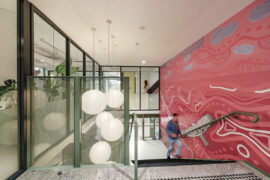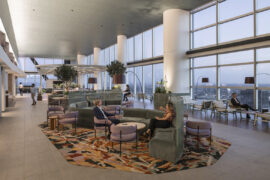Deb Robbins, T.C.L Brisbane Studio principal, shares her vision for a series of catchment ‘corridors’ to unify the city.

Auckland Waterfront Silo Park, landscape architecture and urban design by T.C.L, photography by Jonny Davis.
December 19th, 2023
This comment piece was written by Deb Robbins.
Brisbane’s waterways could be the key to new and innovative ways to encourage locals and visitors to better engage with the city’s subtropical beauty. In fact, this type of important work has already begun. The Brisbane River serves as a compelling prototype of sorts — illuminating how natural bodies of water can be used as connecting devices. Over the past 20 years, the ‘river resurgence’ has positively impacted how people live, work and commute.
We now enjoy daily interactions with the river — riverside walking, cycling and running have become popular pastimes. Meanwhile, Brisbane’s bridges work well to connect northern and southern commuters with the city’s beating heart.

But more can be done…
Other parts of Brisbane’s waterways are yet to be leveraged to full effect. Many locals might be unaware the city actually comprises close to 40 major creek catchments that may well be Brisbane’s quiet achievers.
We have a wonderful untapped resource within our creek catchments’ system. Due to their locations and innate beauty, creek catchments have the potential to become powerful connectors — that draw people down to our waterways and up to surrounding amenities.
I’d love to see our city adopt a series of ‘catchment corridors’ (consisting of boardwalks and permeable pavements) that entice people to engage with their local waterways via ‘greener’ commutes to nearby workplaces, schools and local communities.
Related: UQ Student Central by Hassell

Could a series of catchment corridors transform the ‘river city’?
Restoring, connecting and activating Brisbane’s catchment system has myriad benefits, wellbeing is chief among them. We have ample evidence to support the belief that our wellbeing improves when we engage with nature. These catchment corridors could give people a vital ‘green hit’, as they walk along the water’s edge, observe the local wildlife and take in some gentle exercise.
Regenerative steps, like increased planting around catchment sites, can also spark increased habitat movement through urban areas. This movement enriches biodiversity in a way that benefits local wildlife. Think possums, wallabies, koalas and birds making use of a much broader patch for feeding and mating. Working with Country, and drawing upon the insights of First Nations people, is also essential to ensuring regeneration is done in such a way that complements Brisbane’s local ecology.
These catchment corridors also have the potential to generate employment opportunities. New cafes and/or other small hospitality businesses could capitalise on the influx of people embracing creeks’ edges — providing a welcome retreat/refreshment at the end of sojourns along the water.
Additionally, maintenance of catchment corridors could bolster local employment. To supplement voluntary community catchment groups, a cohort of Creek Rangers could be established to help maintain the sites. We need more well-trained land carers in the urban realm.

Pilot program
Realising a concept like catchment corridors could be years, possibly decades, in the making. Suffice to say, such big and bold ideas require a pilot program. Locations near Olympic Games’ precincts could be the ideal starting point. Some are already underway and I really hope more will follow.
Imagine having catchment corridors to give people an alternative commute to events — one that gets them out into nature and walking along waterways that deliver them to the base of a major Olympic precinct!
T.C.L
tcl.net.au
Photography
Various


INDESIGN is on instagram
Follow @indesignlive
A searchable and comprehensive guide for specifying leading products and their suppliers
Keep up to date with the latest and greatest from our industry BFF's!

Now cooking and entertaining from his minimalist home kitchen designed around Gaggenau’s refined performance, Chef Wu brings professional craft into a calm and well-composed setting.

At the Munarra Centre for Regional Excellence on Yorta Yorta Country in Victoria, ARM Architecture and Milliken use PrintWorks™ technology to translate First Nations narratives into a layered, community-led floorscape.

Merging two hotel identities in one landmark development, Hotel Indigo and Holiday Inn Little Collins capture the spirit of Melbourne through Buchan’s narrative-driven design – elevated by GROHE’s signature craftsmanship.

From radical material reuse to office-to-school transformations, these five projects show how circular thinking is reshaping architecture, interiors and community spaces.

Designed by Woods Bagot, the new fit-out of a major resources company transforms 40,000-square-metres across 19 levels into interconnected villages that celebrate Western Australia’s diverse terrain.

In an industry where design intent is often diluted by value management and procurement pressures, Klaro Industrial Design positions manufacturing as a creative ally – allowing commercial interior designers to deliver unique pieces aligned to the project’s original vision.
The internet never sleeps! Here's the stuff you might have missed

BLP’s new Sydney Children’s Hospital, Randwick building brings together paediatric care, family-centred design and Australia’s first Children’s Comprehensive Cancer Centre in a major addition to the Randwick Health & Innovation Precinct.

Tongue & Groove hosted a lively gathering to celebrate two new collections by Greg Natale, bringing together designers and industry peers.

Melbourne-based Studio Edwards has designed Shift+Space, a modular system under the banner of ‘adaptive retail architecture’. Ben Edwards tells us more.

At the Munarra Centre for Regional Excellence on Yorta Yorta Country in Victoria, ARM Architecture and Milliken use PrintWorks™ technology to translate First Nations narratives into a layered, community-led floorscape.